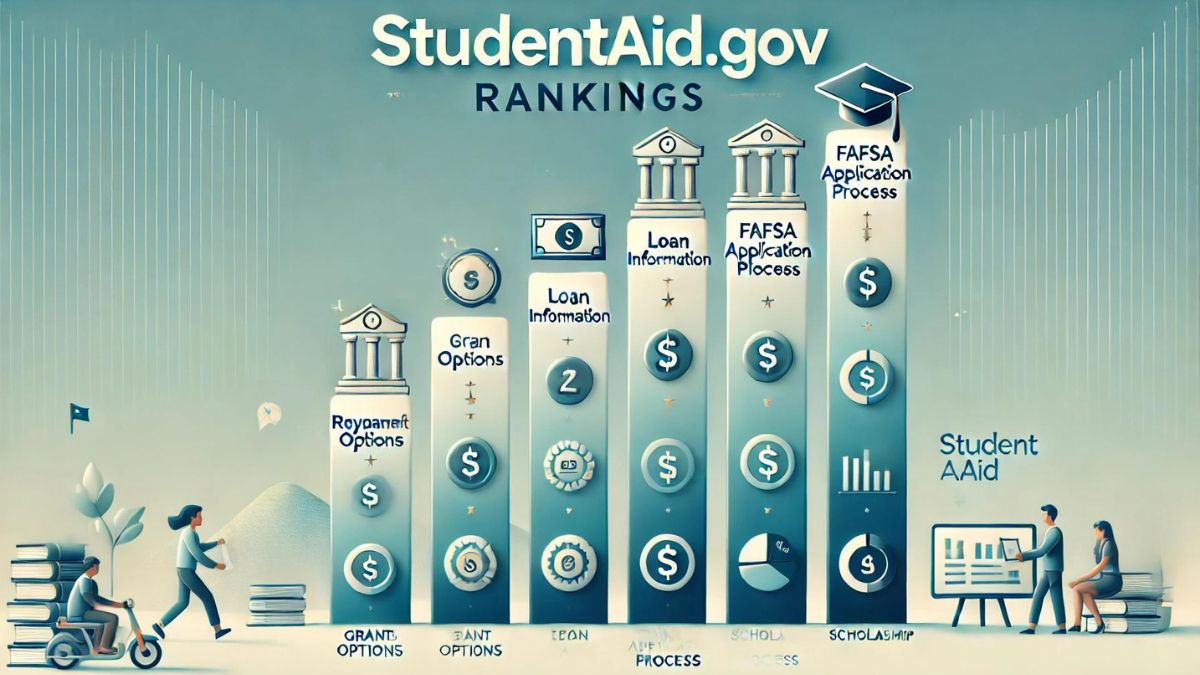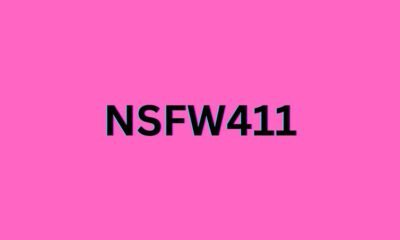INSURANCE
Top 15 Features of StudentAid.gov: A Comprehensive Ranking for 2024

Navigating the world of student financial aid can be overwhelming, but StudentAid.gov serves as a central hub for all your needs. From applying for financial aid to managing your student loans, this platform offers a comprehensive range of tools and resources to help students and their families. This article ranks the key features and services of StudentAid.gov, guiding you through how to make the most of what this essential website offers.
Understanding StudentAid.gov: An Overview
StudentAid.gov is the U.S. Department of Education’s official website for federal student aid. It provides students and families with critical information and tools to plan, apply for, and manage federal financial aid. Whether you are a prospective student, a current student, or a graduate repaying loans, StudentAid.gov is designed to support your educational journey.
Key Functions of StudentAid.gov:
- FAFSA Application: The most crucial tool for applying for federal financial aid.
- Loan Management: Information on federal loans, including repayment plans and forgiveness programs.
- Financial Aid Overview: Guidance on grants, scholarships, and work-study opportunities.
- Account Management: Tools to track your financial aid history and loan status.
The Free Application for Federal Student Aid (FAFSA®)
The FAFSA is the gateway to accessing federal student aid, and it’s one of the most significant features of StudentAid.gov. Completing this form determines your eligibility for federal grants, loans, and work-study funds.
Key Points About FAFSA:
- Annual Submission: Must be submitted every year you need financial aid.
- Critical Deadlines: Each state and school may have different deadlines.
- Required Information: Includes tax information, income details, and family financial status.
Tips for FAFSA Submission:
- Early Application: Apply as soon as possible after October 1 to maximize your aid eligibility.
- Accuracy: Double-check all entered information to avoid delays.
- IRS Data Retrieval Tool: Use this tool to import tax information directly, reducing errors.
Federal Student Loans
StudentAid.gov provides detailed information about federal student loans, which are often more favorable than private loans due to lower interest rates and more flexible repayment options.
Types of Federal Student Loans:
- Direct Subsidized Loans: For undergraduate students with demonstrated financial need.
- Direct Unsubsidized Loans: Available to undergraduate, graduate, and professional students; not based on financial need.
- Direct PLUS Loans: For graduate students and parents of dependent undergraduates.
- Direct Consolidation Loans: Combine multiple federal student loans into one for easier management.
Loan Management Tools:
- Loan Simulator: Helps estimate your monthly payments and compare repayment plans.
- Repayment Plans: Options include Income-Driven Repayment (IDR) plans and Standard Repayment.
- Loan Forgiveness Programs: Public Service Loan Forgiveness (PSLF) and Teacher Loan Forgiveness are some of the programs offered.
Grants and Scholarships
Grants and scholarships are forms of financial aid that do not need to be repaid, making them an ideal option for funding education.
Types of Federal Grants Available:
- Pell Grants: For undergraduate students who display exceptional financial need.
- Federal Supplemental Educational Opportunity Grants (FSEOG): Awarded to undergraduates with significant financial need; funds are limited and distributed on a first-come, first-served basis.
- TEACH Grants: For students who intend to teach in a high-need field in a low-income area.
Scholarship Resources:
- Scholarship Search Tool: Use this tool on StudentAid.gov to find scholarships based on personal qualifications and field of study.
- State and Institutional Scholarships: Also available and often require separate applications.
Work-Study Programs
The Federal Work-Study program provides part-time employment to help students pay for education expenses. It encourages community service work and work related to your course of study.
Benefits of Work-Study:
- Flexibility: Work hours are often flexible around your class schedule.
- Earnings: Earnings are paid directly to the student and do not count against future financial aid eligibility.
- Valuable Experience: Gain work experience in a field related to your studies.
Loan Repayment Plans and Tools
Managing student loans effectively is crucial for financial stability after graduation. StudentAid.gov offers various repayment plans and tools to help.
Key Repayment Plans:
- Standard Repayment Plan: Fixed payments over ten years.
- Graduated Repayment Plan: Payments start low and increase every two years.
- Income-Driven Repayment Plans: Payments are based on your income and family size, potentially leading to loan forgiveness after 20-25 years.
Tools for Repayment:
- Loan Simulator: Estimate monthly payments and find the best repayment plan for your situation.
- Automatic Payments: Set up auto-debit to ensure you never miss a payment and may qualify for a 0.25% interest rate reduction.
Public Service Loan Forgiveness (PSLF)
The PSLF program is designed to forgive the remaining balance on your Direct Loans after you have made 120 qualifying monthly payments while working full-time for a qualifying employer.
Eligibility Requirements:
- Qualifying Employment: Government organizations, not-for-profits, and some other public service organizations.
- Eligible Loans: Only Direct Loans are eligible for PSLF.
- Repayment Plan: You must be on an income-driven repayment plan to qualify.
PSLF Waiver and Updates:
- Temporary Expanded PSLF (TEPSLF): Addresses borrowers who were on the wrong repayment plan but made payments that should count towards PSLF.
- Updates: Stay informed on any changes or updates to the PSLF program to maximize your benefits.
Teacher Loan Forgiveness
If you are a teacher, you may be eligible for Teacher Loan Forgiveness, which provides up to $17,500 in loan forgiveness for teachers in low-income schools.
Eligibility Criteria:
- Teaching Service: Must teach full-time for five consecutive years in a qualifying school.
- Loan Type: Available for Direct Subsidized and Unsubsidized Loans and Subsidized and Unsubsidized Federal Stafford Loans.
- Subject Areas: Science, mathematics, and special education teachers may qualify for higher forgiveness amounts.
Managing Your Aid with “MyStudentAid” Mobile App
The MyStudentAid mobile app makes it easier than ever to manage your financial aid on the go. The app provides access to your financial aid information, allows you to complete the FAFSA form, and provides reminders about important deadlines.
Features of the MyStudentAid App:
- FAFSA Completion: Fill out and submit the FAFSA directly from your mobile device.
- Aid Summary: View your financial aid history, loan balances, and grant amounts.
- Repayment Tools: Access repayment calculators and plan details.
Borrower Defense to Repayment
If you believe you were defrauded by your school, Borrower Defense to Repayment may allow you to have your federal student loans forgiven.
Eligibility for Borrower Defense:
- Misleading Information: If your school misled you or engaged in misconduct, you may qualify.
- Filing a Claim: Submit a Borrower Defense application through StudentAid.gov.
- Potential Outcomes: Depending on the case, you may receive full or partial loan discharge.
Income-Driven Repayment Plans
Income-Driven Repayment (IDR) plans adjust your monthly loan payments based on your income and family size, which can make repayment more manageable.
Types of IDR Plans:
- Revised Pay As You Earn (REPAYE) Plan
- Pay As You Earn (PAYE) Plan
- Income-Based Repayment (IBR) Plan
- Income-Contingent Repayment (ICR) Plan
Benefits of IDR Plans:
- Lower Monthly Payments: Payments are set at a percentage of your discretionary income.
- Loan Forgiveness: After 20-25 years of qualifying payments, the remaining loan balance may be forgiven.
Understanding Your Financial Aid Offer
When you receive a financial aid offer from your school, it’s essential to understand the terms and conditions associated with each type of aid.
Components of an Aid Offer:
- Grants and Scholarships: Non-repayable aid.
- Loans: Must be repaid with interest.
- Work-Study: Part-time job opportunities to earn money for school expenses.
Interpreting Your Offer:
- Net Cost: Subtract total aid from your school’s cost of attendance.
- Loan Terms: Pay attention to interest rates, repayment terms, and loan limits.
- Appealing the Offer: If your financial situation changes, you may be able to appeal for more aid.
Exit Counseling for Federal Student Loans
Before you graduate, leave school, or drop below half-time enrollment, you must complete Exit Counseling to understand your loan repayment obligations.
Components of Exit Counseling:
- Loan Details: Understand the terms and conditions of your loans.
- Repayment Options: Learn about different repayment plans and choose the best one for your financial situation.
- Avoiding Default: Strategies to stay on track with payments and avoid default.
Resolving Disputes and Complaints
If you encounter problems with your loans or financial aid, StudentAid.gov offers resources for resolving disputes and filing complaints.
Common Issues and Resolutions:
- Loan Servicer Issues: If you’re having trouble with your loan servicer, you can file a complaint through the Federal Student Aid Feedback Center.
- Fraud or Misconduct: Report fraudulent activities by schools or loan servicers.
- Financial Aid Appeals: Process for appealing financial aid decisions with your school’s financial aid office.
Financial Literacy Tools
Understanding how to manage your finances is crucial for long-term success. StudentAid.gov provides various tools to help you make informed financial decisions.
Financial Literacy Resources:
- Budgeting Tools: Create a budget and track expenses.
- Loan Calculators: Estimate loan payments and understand the long-term cost of borrowing.
- Financial Aid Glossary: Definitions of key financial aid terms to improve your understanding.
Conclusion
StudentAid gov is an indispensable resource for anyone navigating the complexities of student financial aid. From applying for the FAFSA to managing loan repayment, the website offers comprehensive tools and information to support you at every step of your educational journey. By understanding and utilizing the features ranked in this guide, you can maximize your financial aid benefits, minimize debt, and set yourself up for future financial success.
FAQs
How do I apply for federal student aid through StudentAid.gov?
To apply for federal student aid, you need to complete the FAFSA form available on StudentAid.gov. The form becomes available every year on October 1, and it’s crucial to submit it as early as possible.
What is the difference between subsidized and unsubsidized loans?
Subsidized loans are available to undergraduate students with financial need, and the government pays the interest while you’re in school. Unsubsidized loans are available to all students, regardless of financial need, and interest accrues while you’re in school.
Can I access my loan information on StudentAid.gov?
Yes, you can view your federal student loan information, including balances and repayment status, by logging into your account on StudentAid.gov.
What should I do if I’m struggling to make my loan payments?
If you’re having trouble making your loan payments, you should explore income-driven repayment plans, which adjust your monthly payments based on your income. You can also contact your loan servicer for assistance.
How do I qualify for Public Service Loan Forgiveness (PSLF)?
To qualify for PSLF, you must make 120 qualifying payments under an eligible repayment plan while working full-time for a qualifying employer, such as a government or non-profit organization.
What happens if I default on my student loans?
Defaulting on your student loans can have severe consequences, including damage to your credit score, wage garnishment, and loss of eligibility for further federal student aid. It’s important to contact your loan servicer to explore options like loan rehabilitation or consolidation if you’re at risk of default.
INSURANCE
Understanding Unit 102: A Comprehensive Guide

In various educational and professional contexts, “Unit 102” denotes a specific module or course component. Its content varies across disciplines, but it often introduces foundational concepts essential for advanced learning. This article delves into the significance of unit 102 across different fields, highlighting its objectives, typical content, and its role in building a solid knowledge base.
The Role of Unit 102 in Educational Curricula
Unit 102 serves as a building block in many educational programs, providing students with essential knowledge and skills. It often follows an introductory unit (Unit 101) and precedes more specialized modules. The content of unit 102 varies depending on the discipline but generally aims to deepen understanding and prepare students for more complex topics.
Common Themes in Unit 102 Across Disciplines
While the specifics of Unit 102 differ across fields, several common themes emerge:
- Fundamental Concepts: Unit 102 often covers core principles that are crucial for advanced study. For example, in a British Sign Language course, Unit 102 focuses on conversational skills, enabling learners to engage in basic social interactions.
- Practical Skills: Many Unit 102 modules emphasize hands-on skills. In electrical installation programs, Unit 102 addresses health, safety, and environmental considerations, ensuring that learners can work safely and responsibly.
- Professional Practices: Some Unit 102 units introduce industry standards and professional behaviors. In salon management courses, Unit 102 covers presenting a professional image, teaching students the importance of appearance and conduct in a professional setting.
Examples of Unit 102 in Various Fields
To illustrate the diversity of Unit 102, let’s explore its application in different disciplines:
- British Sign Language (BSL): In BSL courses, Unit 102, titled “Conversational British Sign Language,” focuses on developing both productive and receptive skills. Learners engage in simple exchanges, covering topics like describing people, using numbers, discussing interests, and talking about food and drink. The unit emphasizes correct hand shapes, facial expressions, and BSL structure to ensure effective communication.
- Electrical Installation: In the NVQ 2346-03 Level 3 Electrical Installation Qualification, Unit 102 is dedicated to “Health, Safety and Environmental Considerations.” This unit equips learners with the knowledge to apply health and safety legislation in the workplace, assess work environments for hazards, and implement safe working procedures. It covers topics such as risk assessments, safe use of tools and equipment, and environmental legislation compliance.
- Salon Management: For those pursuing a career in the beauty industry, Unit 102 often focuses on “Presenting a Professional Image in a Salon.” This unit teaches learners how to maintain a professional appearance, communicate effectively with clients, and adhere to salon policies. It covers aspects like personal hygiene, appropriate attire, and professional behavior to ensure a positive client experience.
The Importance of Unit 102 in Skill Development
Unit 102 plays a crucial role in bridging the gap between introductory knowledge and more advanced concepts. By focusing on fundamental skills and professional practices, it prepares learners for the challenges of their chosen field. Successfully completing unit 102 often serves as a prerequisite for more specialized units, underscoring its importance in the learning pathway.
Conclusion
Understanding the role and content of Unit 102 is essential for students and professionals across various disciplines. By providing foundational knowledge and skills, Unit 102 sets the stage for advanced learning and professional development. Whether it’s mastering conversational skills in a new language, adhering to safety standards in technical fields, or presenting a professional image in client-facing roles, Unit 102 equips learners with the tools they need to succeed.
FAQs
What is Unit 102?
Unit 102 is a foundational module in many educational and vocational programs, focusing on essential concepts and skills specific to a field of study.
What topics does Unit 102 cover?
The topics vary by discipline but often include core principles, practical skills, and professional practices, such as safety standards, communication skills, or professional image presentation.
Why is Unit 102 important?
It bridges the gap between introductory and advanced concepts, helping learners build a solid foundation for further study or professional development.
Can I take Unit 102 without completing Unit 101?
Typically, Unit 101 is a prerequisite as it introduces basic concepts needed to succeed in Unit 102.
How is Unit 102 assessed?
Assessment methods vary but may include practical demonstrations, written exams, or coursework designed to test both theoretical knowledge and applied skills.
INSURANCE
Understanding Oil Transfer Pumps: A Comprehensive Guide

Oil transfer pump are essential tools in various industries, facilitating the efficient movement of oil and other fluids from one container to another. Whether you’re in the automotive sector, industrial manufacturing, or agriculture, understanding the types, applications, and maintenance of these pumps is crucial. This guide delves into the intricacies of oil transfer pumps, offering insights to help you make informed decisions.
What is an Oil Transfer Pump?
An oil transfer pump is a device designed to move oil from one location to another. These pumps are vital in scenarios where manual transfer would be inefficient or impractical. They come in various designs and capacities, tailored to specific applications and fluid types.
Types of Oil Transfer Pumps
- Manual Pumps: Operated by hand, these are suitable for small-scale operations where precision and control are paramount. They are cost-effective and easy to use but may not be ideal for transferring large volumes.
- Electric Pumps: Powered by electricity, these pumps are efficient and capable of handling larger volumes. They are commonly used in industrial settings where speed and volume are critical.
- Pneumatic Pumps: Utilizing compressed air, pneumatic pumps are ideal in environments where electrical power sources are unavailable or pose a risk. They are often used in hazardous areas due to their safety features.
- Hydraulic Pumps: These pumps use hydraulic power to transfer oil, offering high pressure and flow rates. They are suitable for heavy-duty applications requiring robust performance.
Applications of Oil Transfer Pumps
- Automotive Industry: Used for transferring engine oils, lubricants, and other fluids during maintenance and manufacturing processes.
- Industrial Manufacturing: Essential for moving oils and lubricants in machinery, ensuring smooth operations and reducing downtime.
- Agriculture: Employed in transferring oils for machinery maintenance, ensuring equipment longevity and efficiency.
- Marine: Vital for transferring fuel oils and lubricants in ships and boats, maintaining operational readiness.
Key Features to Consider
When selecting an oil transfer pump, consider the following features:
- Flow Rate: Determines how quickly the pump can transfer oil. Higher flow rates are suitable for large volumes, while lower rates offer precision.
- Viscosity Compatibility: Ensure the pump can handle the viscosity of the oil you intend to transfer.
- Material Construction: Pumps should be made from materials compatible with the oil type to prevent corrosion and degradation.
- Power Source: Choose between manual, electric, pneumatic, or hydraulic based on your operational needs and available resources.
Maintenance and Safety Tips
- Regular Inspection: Periodically check for wear and tear, leaks, and other signs of damage.
- Proper Cleaning: After use, clean the pump to prevent contamination and ensure longevity.
- Follow Manufacturer Guidelines: Adhere to the manufacturer’s instructions for operation and maintenance to ensure safety and efficiency.
- Use Appropriate Personal Protective Equipment (PPE): Always wear suitable PPE to protect against potential hazards during operation.
Conclusion
Oil transfer pumps are indispensable tools across various industries, offering efficient and safe fluid transfer solutions. By understanding the different types, applications, and maintenance practices, you can select the right pump for your needs and ensure its optimal performance over time.
FAQs
What types of oil transfer pumps are available?
There are manual, electric, pneumatic, and hydraulic oil transfer pumps. Each type is suited to specific applications and operational needs.
How do I choose the right oil transfer pump?
Consider factors such as the type of oil, flow rate, viscosity, pump material, and available power sources when selecting a pump.
Are oil transfer pumps safe to use?
Yes, when used according to manufacturer guidelines. Always inspect the pump before use and wear appropriate personal protective equipment (PPE).
How do I maintain an oil transfer pump?
Regularly inspect the pump for wear, clean it after use, and follow the manufacturer’s maintenance recommendations to ensure longevity and efficiency.
INSURANCE
Unlocking Your Future: How to Earn a Free Master’s Degree Online


 CRYPTO3 months ago
CRYPTO3 months agoCrypto-Engine.Pro Blog: Your Go-To Source for Crypto Trading Insights

 GENERAL3 weeks ago
GENERAL3 weeks agoUnderstanding TNA Board: A Comprehensive Guide for Beginners

 GENERAL4 months ago
GENERAL4 months agoEverything You Need to Know About NSFW411: The Ultimate Guide

 ENTERTAINMENT4 months ago
ENTERTAINMENT4 months agoExploring Mywape: Your Guide to Quality Vaping

 FOOD5 months ago
FOOD5 months agoExploring the Benefits of süberlig: A Comprehensive Guide

 BLOG4 months ago
BLOG4 months agoDiscover the Secrets Behind the /vital-mag.net blog: A Closer Look at the Popular Blog

 FOOD5 months ago
FOOD5 months agoUnveiling the Beauty of Tamisie: A Guide to this Exquisite Fabric

 ENTERTAINMENT4 months ago
ENTERTAINMENT4 months agoNavigating Erome: Tips and Tricks for a Safer Experience on Adult Platforms





















